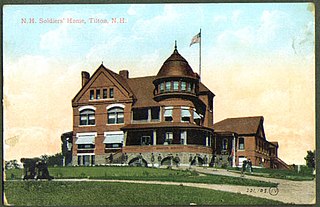
An old soldiers' home is a military veterans' retirement home, nursing home, or hospital, or sometimes an institution for the care of the widows and orphans of a nation's soldiers, sailors, and marines, etc.
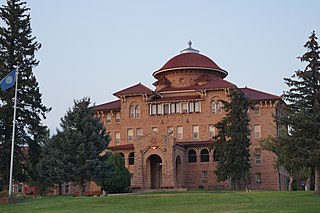
The National Asylum for Disabled Volunteer Soldiers was established on March 3, 1865, in the United States by Congress to provide care for volunteer soldiers who had been disabled through loss of limb, wounds, disease, or injury during service in the Union forces in the American Civil War. Initially, the Asylum, later called the Home, was planned to have three branches: in the Northeast, in the central area north of the Ohio River, and in what was then considered the Northwest, the present upper Midwest.

Camp Chase was a military staging and training camp established in Columbus, Ohio in May 1861 after the start of the American Civil War. It also included a large Union-operated prison camp for Confederate prisoners during the American Civil War.

Dayton National Cemetery is a United States National Cemetery located in the city of Dayton in Montgomery County, Ohio. It encompasses 116.8 acres (47.3 ha) and as of July 18, 2019, had 55,359 interments. In January, 2014, it was one of only fourteen cemeteries to be designated as a national shrine. A new 2,000 niche columbarium was dedicated on July 24, 2014. It is one of a few National Cemeteries with their own Honor Squad. Since its formation, unless refused by family and during a few weeks the National Cemetery Administration disallowed military honors in their cemeteries, no veteran has been buried without a Rifle Salute in addition to "Taps" and the folding and presentation of the Flag. It is also the only National Cemetery with the remains of a funeral tunnel which once allowed deceased veterans to be removed from the Home Hospital to the cemetery. Plans are in process to restore the entrance into the tunnel to its original form.
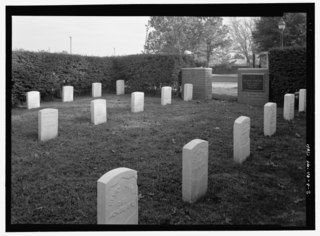
Hampton Veterans Affairs Medical Center National Cemetery is a United States National Cemetery located the city of Hampton, Virginia. It encompasses only 0.2 of an acre, and has 22 interments. It is currently closed to new interments.

Togus, formally known as the Togus VA Medical Center, is a facility operated by the United States Department of Veterans Affairs in Chelsea, Maine. The facility was built as a resort hotel, and housed Union veterans of the American Civil War prior to being converted to a veterans hospital. It was the first veterans facility developed by the United States government.

The Director's Quarters, Togus Veterans' Administration Center, previously known as the Governor's House, is a historic house on the grounds of the Veterans Administration (VA) facility in Togus, Maine. The house, built in 1869, is historically significant as the only surviving structure of the first National Home for Disabled Volunteer Soldiers, established at Togus in 1866 to serve American Civil War veterans. It was designated a National Historic Landmark in 1974. It is a contributing element of the historic district encompassing the Togus VA campus.

Wadsworth Chapel, also known as the Catholic-Protestant Chapels, is actually two separate chapels under one roof on the campus of the Dept. of Veterans Affairs Medical Center in West Los Angeles, California. The structure was built in 1900 and was closed in 1971 after being damaged in the 1971 Sylmar earthquake. It is the oldest building on Wilshire Boulevard and was listed in the National Register of Historic Places in 1972. The structure has fallen into a state of disrepair due to the lack of funds within the Dept. of Veterans Affairs to pay for the required repairs and renovation.

The Sawtelle Veterans Home was a care home for disabled American veterans in what is today part of the Los Angeles metropolitan area in California in the United States. The Home, formally the Pacific Branch of the National Home for Disabled Volunteer Soldiers, was established in 1887 on 300 acres (1.2 km2) of Rancho San Vicente y Santa Monica lands donated by Senator John P. Jones and Arcadia B. de Baker. The following year, the site grew by an additional 200 acres (0.81 km2); in 1890, 20 acres (0.081 km2) more were appended for use as a veterans' cemetery. With more than 1,000 veterans in residence, a new hospital was erected in 1900. This hospital was replaced in 1927 by the James W. Wadsworth Hospital, now known as the West Los Angeles VA Medical Center.

The National Home for Disabled Volunteer Soldiers, Marion Branch is a historic old soldiers' home located in Marion, Indiana. The hospital, along with Marion National Cemetery were listed on the National Register of Historic Places in 1999 as a national historic district.
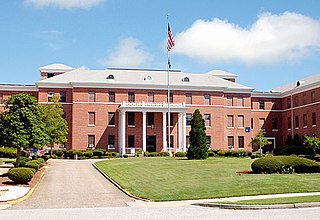
The Tuskegee Veterans Administration Medical Center began in 1923 as an old soldiers' home in Tuskegee, Alabama. It was originally called the Tuskegee Home, part of the National Home for Disabled Volunteer Soldiers system.

The Northwestern Branch, National Home for Disabled Volunteer Soldiers Historic District is a veterans' hospital in Milwaukee, Wisconsin with roots going back to the Civil War. Contributing buildings in the district were constructed from 1867 to 1955, and the 90 acres (36 ha) historic district of the Milwaukee Soldiers Home campus lies within the 400 acres (160 ha) Clement J. Zablocki VA Medical Center grounds, just west of Miller Park.

Ward Memorial Hall is an 1880s theater building within the Northwestern Branch, National Home for Disabled Volunteer Soldiers Historic District, located in Milwaukee, Wisconsin. It is part of the Milwaukee Soldiers Home complex, designated Building No. 41, on the present day Clement J. Zablocki VA Medical Center grounds.
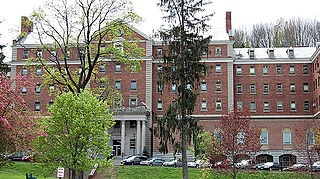
Bath VA Medical Center is a U.S. Veterans Administration hospital located in Bath, Steuben County, New York. Affiliated with the University of Rochester School of Medicine, it provides secondary care and operates clinics in Elmira and Wellsville, New York; and Coudersport and Wellsboro, Pennsylvania. It was added to the National Register of Historic Places in 2013, and designated a national historic district.

The Bedford Veterans Affairs Medical Center, also known as the Edith Nourse Rogers Memorial Veterans Hospital, is a medical facility of the United States Department of Veterans Affairs (VA) at 200 Springs Road in Bedford, Massachusetts. Its campus once consisted of about 276 acres (112 ha) of land, which had by 2012 been reduced to 179 acres (72 ha). The hospital was opened in 1928 to treat neuropsychiatric patients, but now provides a wider array of medical services. Through the efforts of Congresswoman Edith Nourse Rogers, the center was expanded to offer services to women in 1947; her role led to the center being renamed in her honor by President Jimmy Carter.
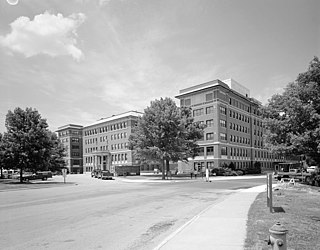
The Western Branch of the National Home for Disabled Soldiers was established in 1885 in Leavenworth, Kansas to house aging veterans of the American Civil War. The 214-acre (87 ha) campus is near Fort Leavenworth, and is directly adjacent to Leavenworth National Cemetery, south of Leavenworth town. The home features about 82 contributing building resources, constructed between the 1880s and the 1940s. It is now part of the Department of Veterans Affairs Eisenhower Medical Center.
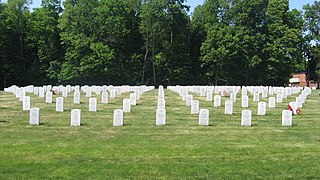
The Danville Branch, National Home for Disabled Volunteer Soldiers Historic District is the historic campus of a branch of the National Home for Disabled Volunteer Soldiers in Danville, Illinois. The branch, which opened in 1898, was one of eleven branches of the National Home, which formed in 1867 to treat Union soldiers disabled during the Civil War. U.S. Representative and Danville resident Joseph Gurney Cannon used his political influence to establish the Danville Branch, which brought money and jobs to the city. The campus served as both a medical facility and a planned community for the area's veterans, and it included housing, veteran-run shops, community halls, a school and library, and a chapel. Most of these buildings were designed in the Georgian Revival style; however, the library is a Classical Revival building, and the chapel has a Gothic Revival design. The campus also includes the Danville National Cemetery. The buildings remaining on the campus are presently divided between Danville's Veterans Affairs hospital and the Danville Area Community College.
Wadsworth was an unincorporated community in Delaware Township, Leavenworth County, Kansas, United States. It is part of the Kansas City metropolitan area.
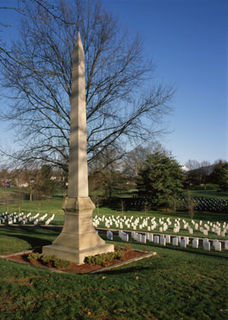
The Mountain Branch, National Home for Disabled Volunteer Soldiers was an old soldiers' home opened in 1904 in Mountain Home, Johnson City, Tennessee. Its site has since been taken over by the United States Department of Veterans Affairs, and is home to the Mountain Home National Cemetery and the James H. Quillen VA Center. Also known as the Mountain Home, its campus was designated a National Historic Landmark District in 2011, as a well-preserved example of an early 20th-century veterans care facility.

The Battle Mountain Sanitarium was a division of the National Home for Disabled Volunteer Soldiers (NHDVS) located in Hot Springs, South Dakota. Established by law in 1902 and opened in 1907, it was unique among the facilities of the NHDVS, a precursor of today's United States Department of Veterans Affairs (VA), in that it was strictly a medical facility with no residential components beyond its treatment facilities. It was founded to treat former soldiers suffering from musculo-skeletal problems that were believed to be treatable by the region's mineral springs, and for conditions such as tuberculosis whose treatment was improved by the thin dry air. The facilities built for the sanitarium are in an architecturally distinctive Romanesque and Mission Revival style, and now form the centerpiece of the Black Hills Health Care facility, operated by the VA. Most of the complex site was designated a National Historic Landmark in 2011 for its architecture and history.























